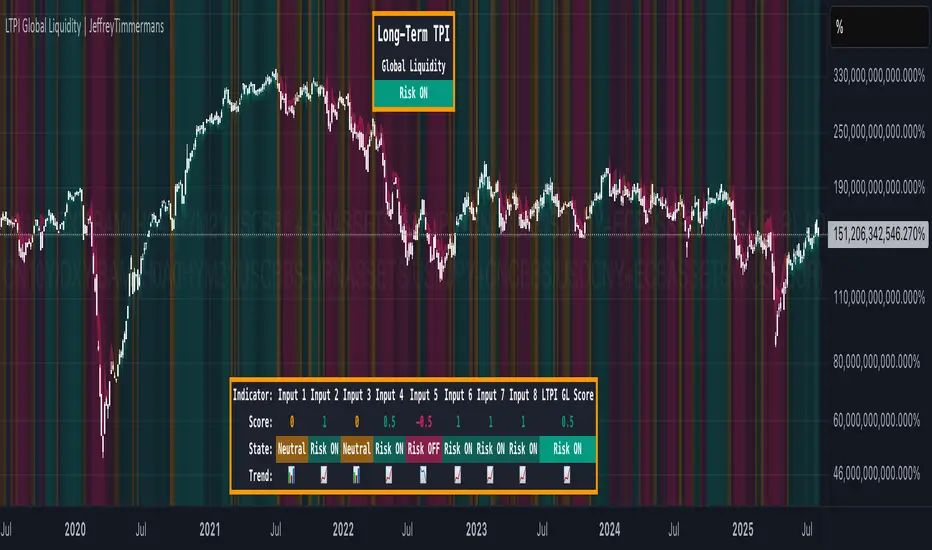LTPI Global Liquidity | JeffreyTimmermans

The "Long-Term Probability Indicator (LTPI)" on a generic liquidity ticker is a custom-built analytical tool designed to evaluate market conditions over a long-term horizon, with a strong focus on global liquidity trends. By combining six carefully selected input signals into a single probability score, this indicator helps traders and analysts identify prevailing long-term market states: Bullish, Bearish, or Neutral.
Where short-term systems/timeframes react quickly to price fluctuations, LTPI smooths out noise and focuses on the bigger picture, allowing for informed strategic decision-making rather than short-term speculation.
Key Features
Multi-Input Aggregation:
- Uses six independent inputs, each based on long-term liquidity and macro-related data, to generate a composite market probability score.
Long-Term Focus:
- Prioritizes medium-to-long-term trends, ignoring smaller fluctuations that often mislead traders in volatile markets.
Simplified Market States:
Classifies the global market into three primary states:
- Bullish: Favorable liquidity and conditions for long-term risk-taking.
- Bearish: Tightening liquidity and conditions that require caution.
- Neutral: Transitional phases or uncertain conditions.
Background Coloring:
- Visual cues on the chart help identify which regime is active at a glance.
Global Liquidity Perspective:
- Designed for use on a generic liquidity ticker, based on M2 money supply, to track macroeconomic liquidity flows and risk appetite.
Dashboard Display:
- A compact on-screen table summarizes all six inputs, their states, and the resulting LTPI score.
Dynamic Alerts:
- Real-time alerts signal when the LTPI shifts from one regime to another.
Inputs & Settings
LTPI Inputs:
- Input Sources (6): Each input is a carefully chosen trend following indicator.
- Weighting: Each input contributes equally to the final score.
Score Calculation:
- Bullish = +1
- Bearish = -1
- Neutral = 0
Color Settings:
- Strong Bullish: Bright Green
- Weak Bullish: Light Green
- Neutral: Gray/Orange
- Weak Bearish: Light Red
- Strong Bearish: Bright Red
(Colors can be customized.)
Calculation Process
Collect Data:
- Six long-term inputs are evaluated at each bar.
Scoring:
- Each input’s state contributes +1 (bullish), -1 (bearish), or around 0 (neutral).
Aggregate Probability:
- The LTPI Score is calculated as the sum of all six scores divided by 6, resulting in a value between -1 and +1.
Market Classification:
- Score > 0.1: Bullish regime
- Score < -0.1: Bearish regime
- -0.1 ≤ Score ≤ 0.1: Neutral
Background Coloring:
- Background colors are applied to highlight the current regime.
How to Use LTPI
Strategic Positioning:
- Bullish: Favor holding or adding to long-term positions.
- Bearish: Reduce risk, protect capital.
- Neutral: Wait for confirmation before making significant moves.
Confirmation Tool:
- LTPI works best when combined with shorter-term indicators like MTPI or trend-following tools to confirm alignment across multiple timeframes.
Dynamic Alerts:
- Bullish Regime Entry: When the LTPI Score crosses above 0.1.
- Bearish Regime Entry: When the LTPI Score crosses below -0.1.
- Neutral Zone: When the score moves back between -0.1 and 0.1.
These alerts help identify significant macro-driven shifts in market conditions.
Conclusion
The Long-Term Probability Indicator (LTPI) is an advanced, liquidity-focused tool for identifying macro-driven market phases. By consolidating six inputs into a single probability score and presenting the results visually, LTPI helps long-term investors and analysts stay aligned with global liquidity trends and avoid being distracted by short-term volatility.
Script su invito
Solo gli utenti approvati dall'autore possono accedere a questo script. È necessario richiedere e ottenere l'autorizzazione per utilizzarlo. Tale autorizzazione viene solitamente concessa dopo il pagamento. Per ulteriori dettagli, seguire le istruzioni dell'autore riportate di seguito o contattare direttamente JeffreyTimmermans.
TradingView NON consiglia di acquistare o utilizzare uno script a meno che non si abbia piena fiducia nel suo autore e se ne comprenda il funzionamento. È inoltre possibile trovare alternative gratuite e open source nei nostri script della community.
Istruzioni dell'autore
Declinazione di responsabilità
Script su invito
Solo gli utenti approvati dall'autore possono accedere a questo script. È necessario richiedere e ottenere l'autorizzazione per utilizzarlo. Tale autorizzazione viene solitamente concessa dopo il pagamento. Per ulteriori dettagli, seguire le istruzioni dell'autore riportate di seguito o contattare direttamente JeffreyTimmermans.
TradingView NON consiglia di acquistare o utilizzare uno script a meno che non si abbia piena fiducia nel suo autore e se ne comprenda il funzionamento. È inoltre possibile trovare alternative gratuite e open source nei nostri script della community.